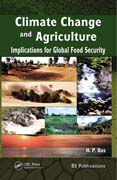
One of the greatest challenges facing humankind is to minimize the impact of human-induced climate change on the agricultural production and also on the production from livestock, forestry and fisheries sectors. Ever-expanding global population and increased income is likely to generate an increase in demand for food and fibre by the middle of this century. At the same time the lands and fresh water resources available for expansion of agriculture may be of lower quality than those currently in use. In order to minimize possible adverse consequences including production losses, food price increases, and food insecurity, there needs to be greater intensive agriculture. This can be achieved by adoption of efficient adaptation techniques in combination with measures taken to preserve the environment and to use resources more efficiently. The range of adaptation options for agriculture, forestry, and fisheries is generally increasing because of technological advances, thus reducing the vulnerability of these systems to climate change. However, in many developing countries technology generation, innovation, and adoption are too slow to sufficiently counteract the increasingly negative effects of climate change. This book represents a major step in understanding the science of various aspects of climate change with likely impacts on agriculture, livestock, forestry, and fisheries with clear adaptation strategies required to reduce their vulnerability.
- ISBN: 9781498769761
- Editorial: CRC PRESS LLC
- Encuadernacion: Tela
- Páginas: 615
- Fecha Publicación: 21/03/2016
- Nº Volúmenes: 1
- Idioma:
